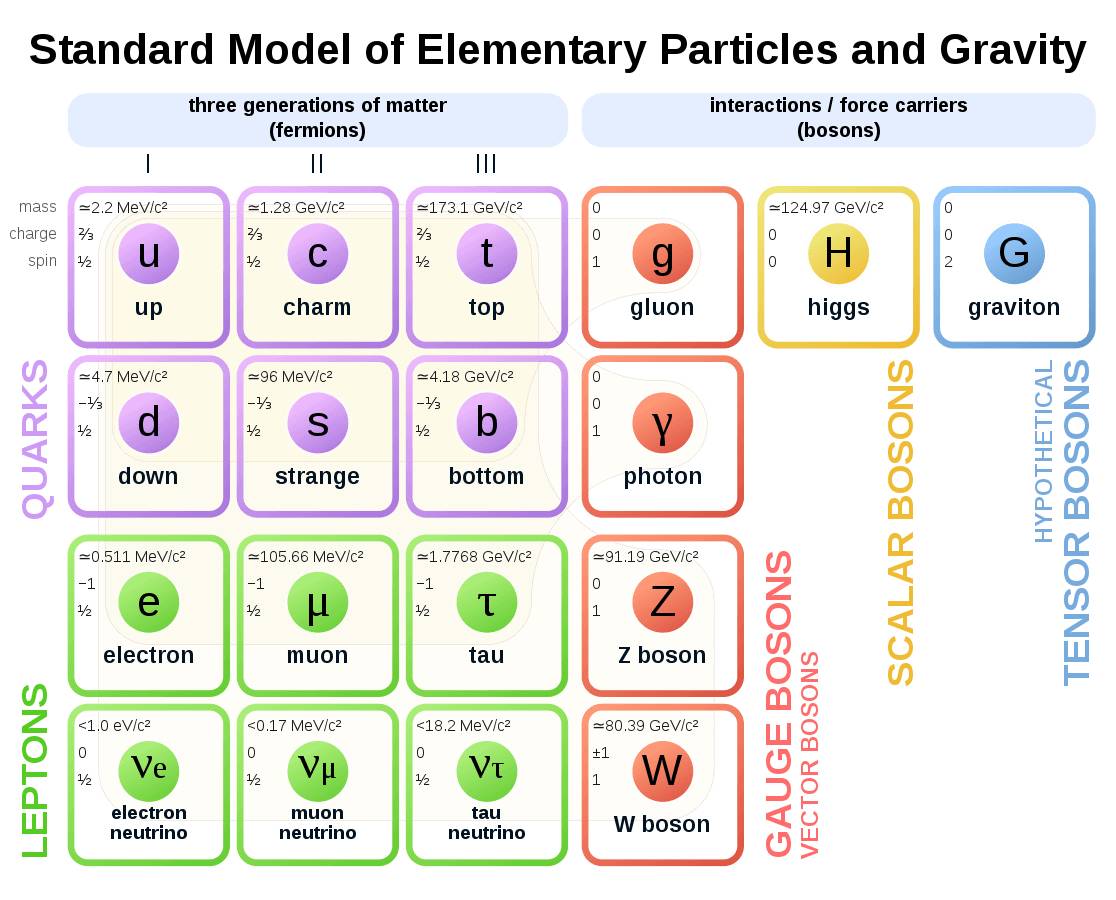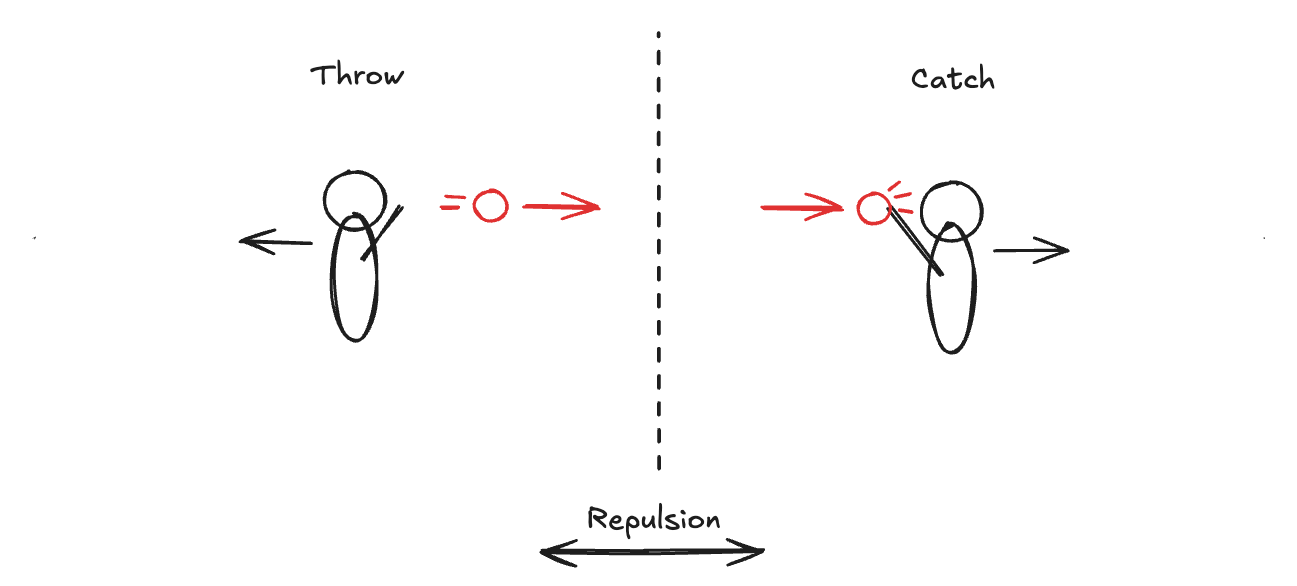Fermions (matter) interact by exchanging bosons (force)
The standard model in particle physicals refers to the elementary subatomic particles. These particles are fundamental towards understanding the foundation of reality, which is composed of fields and energy fluctuations within.
As of now, there are 17 known fundamental particles. It is important to note that the standard model is incomplete, as it fails to explain gravity or address dark matter and dark energy.
The particles are grouped into 2 categories:
Fermions
- Represent matter
- No two can occupy the same quantum state simultaneously (Pauli Exclusion Principle)
- Categorized by a half-integer spin
Bosons
- Mediate forces
- Can condense into the lowest energy state, behaving as a single quantum entity
- Categorized by a full-integer spin
To put it in simpler way, Fermions interact by exchanging bosons. We experience this as matter interacting through forces.

Fermions
Quarks
- Experience all 4 fundamental forces
- Never found in isolation, always bound in groups called hadrons
Quantum Chromodynamics (QCD): Quarks possess a property called Color Charge, which comes in three types: red, green, and blue. Quarks exchange gluons in order to bind together.
Color Confinement: Quarks cannot exist in isolation, they are always confined within composite particles called hadrons.
Hadrons consist of 2 types:
- Baryons: Composed of three quarks (protons, neutrons).
- Mesons: Composed of a quark and an antiquark
Leptons
- Do not experience the strong force
- Exist as isolated particles
Muons and taus are heavy and unstable, and quickly decay. Neutrino versions of the 3 leptons have a neutral charge and very weak interactions.
in an atom, the nucleus is composed of quarks, bound by the strong force, while the electrons are a lepton, balancing the charge and enabling chemical bonds and interactions.
The three generations
There are 3 sets, or generations, of fermions. Each containing 2 quarks and 2 leptons (see chart above)
The higher generations are more massive and unstable, and typically quickly decay into the 1st generation.
Bosons
The 4 Gauge Bosons relate to 3 of the 4 fundamental forces, excluding gravity. These forces are expressed by the exchange of these bosons by fermions.
The Gauge Bosons are also known as Vector Bosons because they posses a distinct direction within their field. They can impart momentum and direction changes onto fermions.
Gluon
Represents the strong nuclear force. The exchange of gluons by quarks is what binds them together into hadrons, and also what binds hadrons themselves.
The energy of these interactions is the primary source of mass within ordinary matter. To understand this better, remember Einstein’s mass-energy equivalence: E = mc^2 which shows mass is constrained energy.
The intrinsic mass of the quarks within a proton only accounts for 2% of the mass of the proton. The rest (98%) is contained solely in the binding energy of the strong force. This implies that physical matter is actually the result of dynamic quantum energy.
Photon
The photon is the carrier of the electromagnetic force, and is primary exchanged by electrons, but interact with any particle that has a charge.
When a charged particle absorbs or emits a photon its energy, momentum, and direction change.
Example: Electrons (fermion) repel each other by exchanging photons (boson).
Think of two astronauts in outer space throwing a ball back and forth. Due to Newton’s third law, a small amount of momentum is imparted both on the thrower and the catcher on each throw, resulting in them moving apart. This is why particles of the same charge repel each other, and also why the force is stronger the closer they are - the ball is thrown at a faster rate.

In the diagram, the astronauts represent electrons, while the red ball is a photon.
A photon is a massless particle, which gives it the unintuitive properties found at the extremes of Special Relativity. It travels at the speed of light, and doesn’t experience time. It’s length is also infinite and behaves as a wave until it is collapsed into representing a particle, as discovered in the x Wave-particle duality.
Z and W Bosons
Both the Z and W Bosons are carriers of the weak nuclear force This force is associated with the decay of particles.
The W and Z bosons are very massive compared to other gauge bosons, which gives the weak force a very short range.
Flavor changing is the process of a fermion changing into a different type of fermion, for example an up quark converting into a down quark by emitting a W boson. This is the process behind radioactive decay.
The Scalar Boson
There is another type of boson that does not possess a direction in it’s field. The Higgs Boson, x The Scalar Boson.
The Graviton
The final boson is theoretical and not yet detected. A massless, charge-less boson with an integer spin of 2 is theorized to be the carrier of the 4th fundamental force, gravity.
However, gravity appears to have no interactions at the subatomic scale. It is too weak. It may also signal a fundamental misunderstanding of what gravity is.
There is a disconnect between the theory that dictates the very small and the very large where gravity isn’t a force but a curvature in spacetime, as explained in General Relativity.
Scientists are seeking a unified theory to explain everything.
Virtual Particles
While these particles appear to exist and exert forces and interactions with each other, this is not the case. The particles are virtual and are generated by fields theorized in Quantum Field Theory.